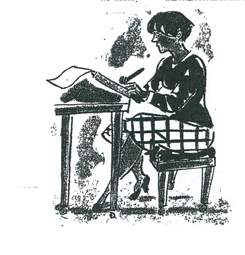
|
Don't Worry
by Beverly Potter, PhD—Be Happy Worry's job is to anticipate danger before it arises and to rehearse how to deal with it—a sort of mental fire drill. But the risk is that you will get caught in worrywarting. Worrywarts keep their mind's eye on the source of anxiety, while ignoring everything else. Smart worriers, on the other hand, catch themselves worrywarting and redirect their momentum into productive action.  Cheryl, the owner of a small toy company, is an example. "When we introduced our new line of 'Love Bears,' our distributor insisted on a run of 50,000 units. No sooner had they hit the warehouse than sales took a nosedive. I was swamped with worry. "Suddenly I saw what I was dong and said to myself, 'Stop it! You're anxious—that's all. It's to be expected with so much money on the line.' Then I asked myself, "What would a friend advise me to do?' The answer was easy: 'Get out there and market those Love Bears' And I thought, Yes! I can make sales happen. After making only two calls I got a new account and sold 1,000 units.!" Through reading their emotions, smart worriers avoid being swept away by a torrent of angst. Cheryl identified her anxiety and recognized it was a natural response to a financial risk—there was no immediate danger. She countered her worrisome thinking and was able to focus on solving her problem. A smart worrier tried
to be her own best friend.
While worrywarts mentally reply a bothersome situation repetitively, working themselves into increasing levels of anxiety, smart worriers challenge their views of the problem, looking at it from several vantage points and focusing on finding solutions. They examine dangers, but once the risk has been studied, they let go of worrying to make contingency plans. When they have a plan, they use their imaginations to rehearse success—wile worrywarts envision disaster. Worrywarts tend to exaggerate the risks, while smart worriers break big worries in |
to smaller pieces and
proceed with small-step solutions to these more
manageable sub-problems. They also differentiate
between what they can and what they can't do something
about, while worrywarts worry uselessly about things
they cannot change. When something is beyond their
control, smart worriers don't stew about it.
Instead, they focus on what they can do something
about—as Cheryl did when she decided to make phone
calls. Worry is an inner dialogue called "self-talk," a talking it over with yourself as a way to cope with bothersome situations. The nature of that dialogue is powerful in shaping how you feel and what you do. Worrywarts' self-talk is judgmental, critical and scary, keeping them unnerved as it triggers more worry. Smart worriers talk to themselves the way a friend would. Friends encourage, give permission and challenge extremes. Think of a worry you've been dwelling on. Imagine sharing this problem with a dear friend. What would your friend say to be supportive and encouraging to soothe you? Pay attention to the words you imagine your friend would sue, and how he or she would say them. "Smart
worriers differentiate between what they can
and what they can't do something about."
A friend focuses on the positive and what's working. A friend builds you up by pointing out your progress and what you've done right. This fosters optimism. Smart worriers come away from a fret session feeling hopeful. Hope is the belief that success is ultimately possible. With hopeful thinking, you can resist anxiety.  Smart worriers think objectively, asking, "What are the facts?" Worrywarts, on the other hand, often forget to separate facts form negative possibilities. For instances, if a worrywart's teenage son has borrowed the family car and failed to return home when expected, she may think, Something terrible has happened, just as if this were fact, when the only fact is her son has not returned home or called. |
Taking action is the best
way to combat worry. Worrywarts tend to exaggerate the risks, while smart worriers break big worries into smaller pieces and proceed with small-step solutions to these more manageable sub-problems. They also differentiate between what they can and what they can't do something about, while worrywarts worry uselessly about things they cannot change. When something is beyond their control, smart worriers don't stew about it. Instead, they focus on what they can do something about—as Cheryl did when she decided to make phone calls. Hope is the belief that
success is ultimately possible.
To see a situation clearly, you must accurately identify any emotions whose presence might cloud the facts. Answering the question "What am I feeling?" will help prevent your ideas, actions and decisions form being driven by your emotions in ways in which you are not aware. For instance, when the mother whose teenage son was late coming home thought about her emotions, she realized that she was afraid something had happened to him and she was angry he was late and hadn't called. Finally, she realized that having these feelings didn't mean something had happened to him. 
She then went on to think supportively, making a list of the strengths and assets of everyone involved in the situation and the resources available for dealing with it. She came up with the following supportive thinking: "My son doesn't speed or drink. Our car is rated one of the safest on the road." Supportive thinking brought her to a more balanced view of the situation. She then challenged her catastrophic view of things, asking herself, "What's possible here?" When she employed this "possibility thinking," she thought of alternatives to the catastrophe, like the car running out of gas. "Maybe his watch stopped?" Even implausible scenarios can contain ideas about how to deal with worrisome situations. Before you worry, get
all the facts.
When used together, these thinking styles can provide a constructive mental approach for dealing with worry. A side benefit is that they feed your peace of mind so that you'll feel better and get more of what you want from life. |